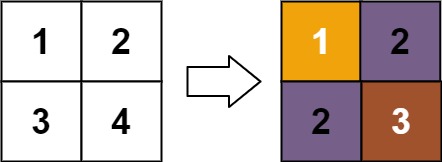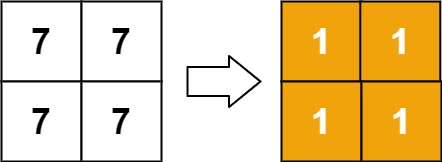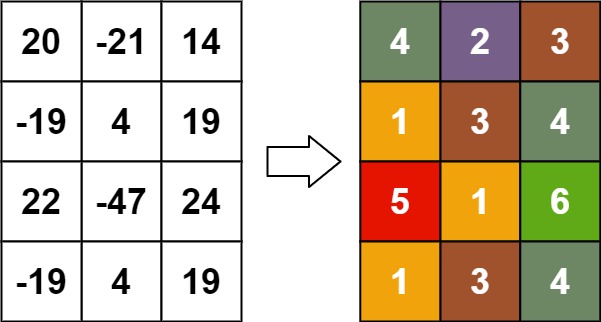- {x}
- Largest Substring Between Two Equal Characters
- Lexicographically Smallest String After Applying Operations
- Best Team With No Conflicts
- Graph Connectivity With Threshold
- Design an Expression Tree With Evaluate Function
- Slowest Key
- Arithmetic Subarrays
- Path With Minimum Effort
- Rank Transform of a Matrix
- Percentage of Users Attended a Contest
- Add Two Polynomials Represented as Linked Lists
- Hopper Company Queries I
- Sort Array by Increasing Frequency
- Widest Vertical Area Between Two Points Containing No Points
- Count Substrings That Differ by One Character
- Number of Ways to Form a Target String Given a Dictionary
- Check Array Formation Through Concatenation
- Read More...

Rank Transform of a Matrix
Given an m x n matrix, return a new matrix answer where answer[row][col] is the rank of matrix[row][col].
The rank is an integer that represents how large an element is compared to other elements. It is calculated using the following rules:
- The rank is an integer starting from
1. - If two elements
pandqare in the same row or column, then:- If
p < qthenrank(p) < rank(q) - If
p == qthenrank(p) == rank(q) - If
p > qthenrank(p) > rank(q)
- If
- The rank should be as small as possible.
The test cases are generated so that answer is unique under the given rules.
Example 1:

Input: matrix = [[1,2],[3,4]] Output: [[1,2],[2,3]] Explanation: The rank of matrix[0][0] is 1 because it is the smallest integer in its row and column. The rank of matrix[0][1] is 2 because matrix[0][1] > matrix[0][0] and matrix[0][0] is rank 1. The rank of matrix[1][0] is 2 because matrix[1][0] > matrix[0][0] and matrix[0][0] is rank 1. The rank of matrix[1][1] is 3 because matrix[1][1] > matrix[0][1], matrix[1][1] > matrix[1][0], and both matrix[0][1] and matrix[1][0] are rank 2.
Example 2:

Input: matrix = [[7,7],[7,7]] Output: [[1,1],[1,1]]
Example 3:

Input: matrix = [[20,-21,14],[-19,4,19],[22,-47,24],[-19,4,19]] Output: [[4,2,3],[1,3,4],[5,1,6],[1,3,4]]
Constraints:
m == matrix.lengthn == matrix[i].length1 <= m, n <= 500-109 <= matrix[row][col] <= 109
Solution Explanation:
This problem requires finding the rank of each element in a matrix based on its relative value within its row and column. The solution uses a Union-Find data structure to efficiently track connected components within the matrix based on element values. Here's a breakdown:
1. Data Structures:
-
Union-Find (Disjoint Set Union): This data structure is crucial for efficiently determining whether elements belong to the same connected component. It uses
find()to get the representative element of a set andunion()to merge two sets.resetis used to reset the sets after processing elements with the same value. -
d(Dictionary/Map): Stores the value of each element as a key and a list of its coordinates (row, column) as the value. This allows for efficient iteration through elements of the same value. -
rowMaxandcolMax: These arrays track the maximum rank encountered in each row and column respectively.
2. Algorithm:
-
Initialization:
- Create a Union-Find data structure with size
m + n(rows + columns). - Initialize
rowMaxandcolMaxarrays with zeros. - Create a dictionary/map
dto store the value and coordinate of elements in the matrix.
- Create a Union-Find data structure with size
-
Iteration:
- Sort the unique element values in ascending order.
- For each value
v:- Iterate through the list of coordinates associated with
v. - Using the Union-Find, unite each cell's row with its column in the union-find data structure. This ensures that cells in the same row or column are in the same set.
- Find the maximum rank within the connected component of each cell (using
rowMaxandcolMax). - Set the rank of the cell to 1 + the maximum rank found in step above.
- Update
rowMaxandcolMaxwith the new rank of the cell. - Reset the sets in the Union-Find, removing the current value's connections. This prepares the union-find for the next set of values.
- Iterate through the list of coordinates associated with
-
Result:
- The
ansmatrix stores the calculated ranks, which is then returned.
- The
3. Time Complexity Analysis:
- Sorting unique values: O(k log k), where k is the number of unique elements in the matrix.
- Iterating through elements of the same value: O(m*n) in the worst case where all elements have different values.
- Union-Find operations (
find,union,reset): Each operation takes almost constant time on average due to path compression and union by rank optimizations. Thus, these operations contribute O(m*n * α(m+n)) to the complexity, where α(m+n) is the inverse Ackermann function, which is very close to a constant for practical purposes.
Therefore, the overall time complexity is dominated by the sorting and iteration steps, resulting in O(m*n + k log k), where m and n are dimensions of the matrix and k is the number of unique elements in the matrix.
4. Space Complexity Analysis:
- Union-Find: O(m + n) space.
d: O(m*n) in the worst case (all elements are unique).rowMax,colMax,ans: O(m + n) space.- Rank array: O(m+n)
Therefore, the overall space complexity is O(m*n).
The provided code in Python, Java, C++, and Go implements this algorithm efficiently. The Union-Find implementation significantly optimizes the connectivity check, making the solution efficient even for large matrices.